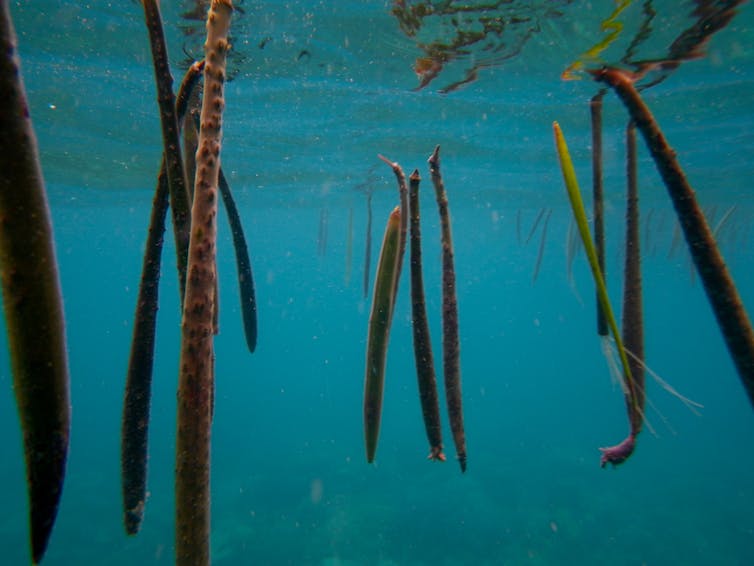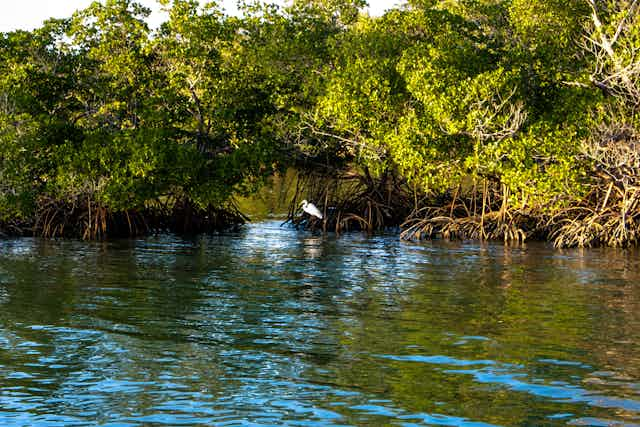With the help of technology, humans can traverse virtually every part of our planet’s surface. But animals and plants are less mobile. Most species can only live in zones where temperature and rain fall within specific ranges.
As regions become warmer due to climate change, plants and animals in those areas will either move to more appropriate climates or be replaced by newcomers who are well-suited to the new conditions. These changes are already occurring. For example, many plants, animals and birds in the Northern Hemisphere have shifted their ranges northward.
My research team studies mangroves – salt-tolerant trees with branches that intertwine like dense jungle gyms. Mangroves line the world’s coastlines and prefer warm temperatures, so they have traditionally been restricted to subtropical and tropical environments. But they have many features that have enabled them to survive major climate shifts in the past. Now, in a harbinger of climate change, mangroves are expanding from tropical zones into temperate areas. Scientists are finding them at higher and higher latitudes in North America, South America, Asia, Africa, Australia and Latin America.
Working with other ecologists in the shadow of the huge launch complex at Florida’s Kennedy Space Center, we have found that mangroves have increased in abundance by 70 percent in just seven years over an area of 220 square miles (567 square kilometers). This is a dramatic change in the plant community along this stretch of the Atlantic coast. Unlike many other impacts of climate change, we expect these shifting ranges to produce some benefits, including increased carbon storage and storm surge protection.

Traveling by water
Plants have less ability to move than animals, but some – particularly mangroves – can disperse via water over thousands of miles. Mangroves release reproductive structures called propagules, similar to seeds, which can produce new plants. They float and are distributed by ocean currents and, sometimes, big storms. As mangrove propagules drift north along the Atlantic coast, they are reaching areas where winter freeze events that could kill them are becoming less common due to climate change. Similar movements are occurring in other locations around the world.
In the Gulf of Mexico and Florida, mangroves are increasingly found in areas recently dominated by salt marshes, which typically occur in cooler zones. Using satellite images and land-based field studies in our ongoing study of mangroves, we can see this spread of mangroves occurring faster than we could have expected based on climate data alone.
Though these shifts also likely happened in the past due to hurricanes and freeze events, the recent changes in mangrove range are still dramatic. One study from Florida shows that mangroves from northern populations may be reproducing earlier than normal and producing bigger propagules, which could help them take over salt marshes.

Stabilizing coastlines
In a recent modeling effort, we examined how mangroves protect NASA facilities at the Kennedy Space Center. We found that a 2-meter-wide strip of mangroves along the shore can reduce wave height by 90 percent. In contrast, it takes 20 meters of salt marsh habitat to reduce waves by the same amount. Other studies have found that mangrove forests helped reduce shoreline damage during the catastrophic 2004 Indian Ocean tsunami and Tropical Storm Wilma in Belize in 2005.
Mangroves around the world have been severely reduced by human activities, particularly clearance for aquaculture. Scientists estimate that at least 35 percent of global mangrove habitat was lost between 1980 and 2000. One recent estimate suggests that mangrove deforestation rates in recent decades have been three to five times faster than other forests around the globe.
All types of coastal wetlands help to prevent millions of dollars in damage from flooding and save hundreds of hours of labor to repair storm damage. Mangrove restoration efforts are ongoing in many parts of the world, including the Tampa Bay estuary and southern China, but some projects have been major failures. To succeed, these initiatives need to consider mangrove habitat needs, particularly hydrology.
Though mangroves may protect coastlines even more effectively than salt marshes, it is important to note that marsh plants provide important habitats for numerous species of birds and fish. We don’t yet know how these animals will fare as mangroves replace marshes, nor do we yet understand other downsides of plant range shifts due to climate change.
Storing carbon in flooded soils
Continued mangrove expansion could increase carbon storage along coastlines. Mangroves have an enormous capacity for sucking up carbon dioxide and other greenhouse gases and trapping them in flooded soils for millennia. They are among the most carbon-rich tropical forests and can store twice as much carbon on a per-area basis as salt marshes. During normal growth, mangroves rapidly convert carbon dioxide into biomass. The saturated soils in which they grow contain low levels of oxygen, which bacteria and fungi need as fuel to break down dead plant matter. Instead, this dead material is stored in the soil.
We estimated in one study that mangrove carbon storage at the Kennedy Space Center increased by 25 percent in only seven years as mangrove forests spread. We concluded that if mangrove expansion continued unchecked by freezes into other southeastern U.S. wetlands, wetland carbon storage could result in the uptake of 26 million metric tons of carbon by 2080. This is equivalent to just over 95 million metric tons of carbon dioxide, which is about 28 percent of Florida’s total greenhouse gas emissions from human activities in 2010.
Preserving coastal mangroves improves climate resilience in several ways. First, if the carbon stored in these soils were released as carbon dioxide and methane, this would likely cause an increase in climatic warming. Second, the same processes that store carbon in wetland soils also allow these wetlands to accrete sediment and keep pace with rising sea levels.
Can mangroves keep delivering these services?
Plants and animals perform many ecosystem services for humans, from pollinating crops to filtering drinking water supplies. As species are shifted around the globe, it is critical to understand whether these services will lessen or increase, and how we can maximize them in a less stable future.
Mangroves are providing extremely valuable services and may become even more important as they expand toward the poles. But according to one recent study, many mangrove ecosystems are not building enough new elevation to keep pace with sea level rise. In a new project, my research group is analyzing how variable climate and mangrove invasion will alter the coastal protection capacity of Florida wetland ecosystems. With a better understanding of this process, we can develop strategies for protecting and restoring these valuable resources.

